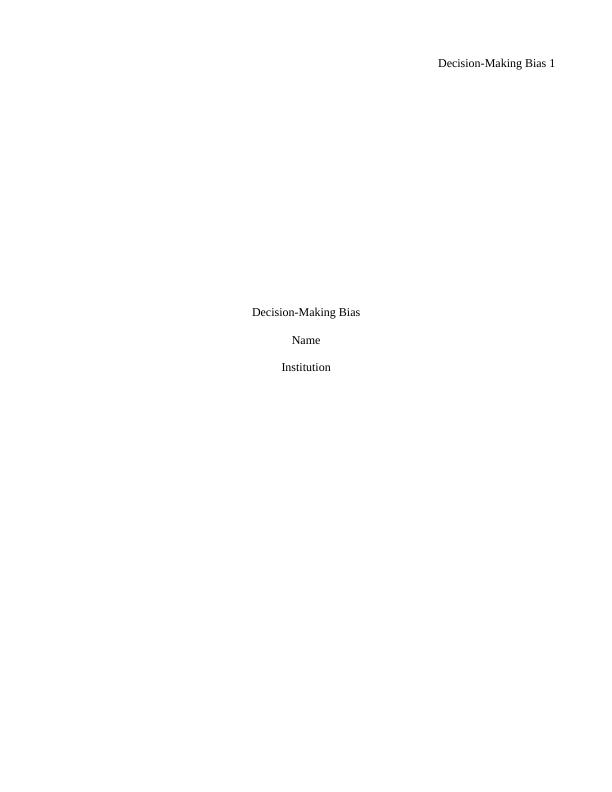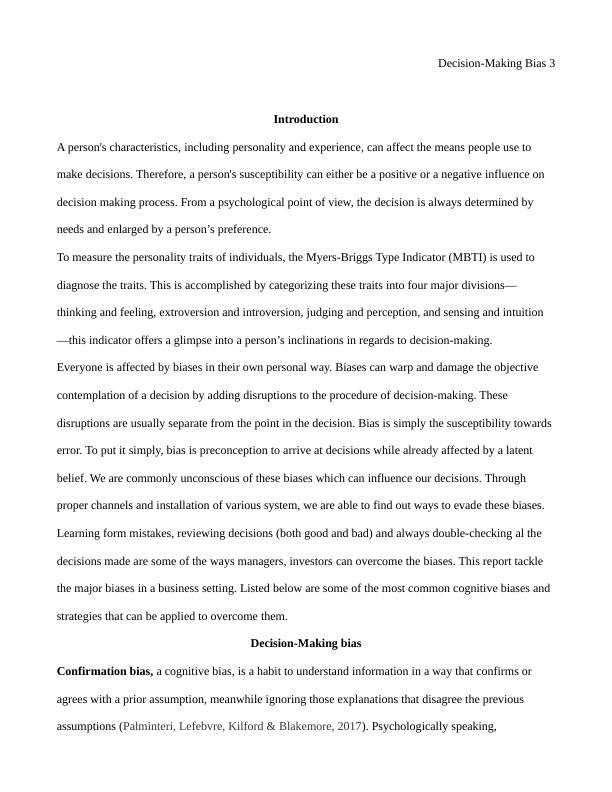(PDF) Biases in the Decision-Making Process
Added on 2021-06-16
13 Pages4719 Words32 Views
Decision-Making Bias 1Decision-Making BiasNameInstitution

Decision-Making Bias 2Table of Contents1.0 Introduction........................................................................................................................................32.0 Decision-Making bias.........................................................................................................................32.0.1Confirmation bias..................................................................................................................32.0.2 Excessive optimism...............................................................................................................42.0.3 Sunk cost .................................................................. .......................................................... 52.0.4 Illusion of control..................................................................................................................52.0.5 Familiarity heuristic..............................................................................................................62.0.6 Loss aversion.........................................................................................................................62.0.7 Group bias.............................................................................................................................72.0.8 Overconfidence bias..............................................................................................................82.0.9 Outcome bias.........................................................................................................................92.0.10 Recency ..............................................................................................................................92.0.11 Selective perception............................................................................................................92.0.12 Availability heuristic..........................................................................................................103.0 Conclusion.........................................................................................................................................104.0 List of references...............................................................................................................................11

Decision-Making Bias 3IntroductionA person's characteristics, including personality and experience, can affect the means people use to make decisions. Therefore, a person's susceptibility can either be a positive or a negative influence on decision making process. From a psychological point of view, the decision is always determined by needs and enlarged by a person’s preference. To measure the personality traits of individuals, the Myers-Briggs Type Indicator (MBTI) is used to diagnose the traits. This is accomplished by categorizing these traits into four major divisions—thinking and feeling, extroversion and introversion, judging and perception, and sensing and intuition—this indicator offers a glimpse into a person’s inclinations in regards to decision-making.Everyone is affected by biases in their own personal way. Biases can warp and damage the objective contemplation of a decision by adding disruptions to the procedure of decision-making. These disruptions are usually separate from the point in the decision. Bias is simply the susceptibility towards error. To put it simply, bias is preconception to arrive at decisions while already affected by a latent belief. We are commonly unconscious of these biases which can influence our decisions. Through proper channels and installation of various system, we are able to find out ways to evade these biases. Learning form mistakes, reviewing decisions (both good and bad) and always double-checking al the decisions made are some of the ways managers, investors can overcome the biases. This report tackle the major biases in a business setting. Listed below are some of the most common cognitive biases and strategies that can be applied to overcome them.Decision-Making biasConfirmation bias, a cognitive bias, is a habit to understand information in a way that confirms or agrees with a prior assumption, meanwhile ignoring those explanations that disagree the previous assumptions (Palminteri, Lefebvre, Kilford & Blakemore, 2017). Psychologically speaking,

Decision-Making Bias 4confirmation bias can be seen even in situations where the idea being proven is a difficult one, this further proves the kind of influence this bias has on human beings. Individually, this bias can affect customer decisions, for example, if a client has previous information about a product (even if the information is wrong), it has a big influence on the decision of whether to purchase a product (Charness& Dave 2017). Confirmation bias, whether looked at from an individual perspective or a corporate one,is influential, meaning, people will automatically choose what hit closer to home and ignore everythingelse. To curb this bias, one needs the ability to question and evaluate their opinions and decisions and the decisions of others. Sources of information are the main influence in this instance, therefore, information sources have to be screened before the information is taken seriously.Excessive optimism is related to the overestimation of the number of likeable results in compared to the unlikeable ones (Clark, Robert & Hampton, 2016 ). This kind of bias exists in a huge array of fields. For example, for the issue of the debt-equity ratio for financing, the main cause for debt problems presently is corporate management’s previous unrestrained optimism. In addition, introducing a fresh product into the market is rarely rid of forecasting bias; Therefore, several of the forecasts contain very many errors. But this is not surprising at all because several of the companies may unwillingly be engaged in unrestrained optimism, especially when their existence is dependent on favourable forecasts (Leong & Zaki, 2018). In addition, it’s not only corporations that suffer this bias, people also show it, both when they are deciding on their investments and in how they live their lives. In a study to investigate the effects of emotion on the value of stocks, it was concluded that emotion surely has an effect on asset valuation. It is very important to stress that the concept of the optimism is not solely considered when judging probable outcomes. Optimism, which is a requirement to have a positive consideration for oneself, is closely connected with a mental health and well-being. Several cognitive research from the 70s and 80s

End of preview
Want to access all the pages? Upload your documents or become a member.
Related Documents
Biases in Decision Making (pdf)lg...
|13
|4378
|140
12 The Common Biases in Decision Making and How They Might Be Overcomelg...
|12
|3132
|259
Heuristics and Bias in Decision Making: Analysis of Human Mind's Capabilitylg...
|10
|1298
|121
Assignment Cognitive Biaseslg...
|5
|728
|16
Behavioural Economicslg...
|10
|2575
|369
Common Biases in Decision-Making and How They Might Be Overcomelg...
|12
|940
|82
